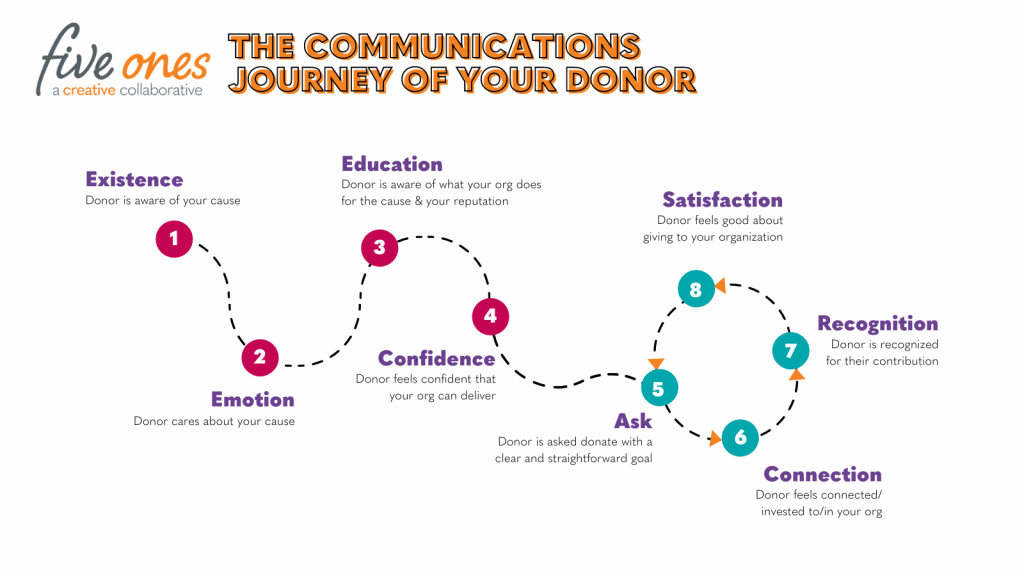The 5 Best Nonprofit Marketing Frameworks (For Marketing Planning Success)
Video Transcript:
Hi! Welcome to the latest episode of The High-Five Nonprofit Marketing Ideas. I’m Julia McDowell, Marketing Strategist for Five Ones. The High-Five is my video series of marketing strategies and tactics for nonprofits and associations. Be sure to click on this link to download the board behind me.
Today I’m talking about marketing frameworks that will set you up for success. Each of these can be used for different types of marketing campaigns and you can use multiple at a time. They’re there to help you in the planning, execution, and review processes to keep you on the right track. Let’s dive in!
9Ps
I bet you know the 4Ps, but do you know there are 5 more Ps? The 9Ps is a framework from 360 Live Media that helps you set up a solid strategy when hosting events. You can download the full framework on their website.
The 9Ps are purpose, people, product, positioning, promotion, packaging, place, price, and performance. Each comes with its own nuances.
For example, consider what purpose your event has for both you and your donors. Then, when it comes to people, who are you targeting? What are the nitty-gritty details of the demographic you’re hoping to reach? Your product is your event, but what are the takeaways for your audience? The rest of the Ps are more straightforward in nature, but their goal is to get you thinking about the seemingly small and interconnected things that make a large event a success.
SMART goals
I used to say a goal is a goal. And don’t worry, I can come up with a smart one. But the acronym SMART truly does help you create goals that are Specific, Measurable, Achievable, Relevant, and Time-bound. So, when you begin to put a marketing plan into action and are deciding on how you will measure success, make sure your end goals are SMART.
Each goal must be specific enough to become a benchmark. For example, growing your number of donors, increasing the number of donations, and surpassing last year’s event attendees. The measurable part is the number attached to the goal. That could be a 25% increase or a certain dollar amount raised. However, make sure the number you’ve set out is achievable. Growing your donor base by 100% probably isn’t reasonable, so look at your past performance and set a realistic, achievable goal. Your goal’s relevancy is why you’re creating the marketing plan in the first place. How is it relevant to the larger organization? Finally, put a time frame on it—build parameters to keep yourself on track.
Donor Motivation Path
In order to increase your number of donors, you have to motivate them to want to become a part of your organization. I cover this path in more depth in another video, but here are the highlights: emotion, education, connection, recognition, and satisfaction.
Give them an emotional reason to donate, whether it’s showcasing your cause and how you help people or having other donors share why they were moved to donate. Then, educate them on how your organization works and where the money goes.
Find a way to continually connect with them by sending relevant content or updates via their preferred channel. You don’t want to be seen as the organization that only asks for donations. And finally, show them that you’re grateful but also that they made a difference. Show them their impact and why it was helpful to continue to build that emotional connection.

SWOT
Another acronym you may be familiar with is SWOT. SWOT stands for Strengths, Weaknesses, Opportunities, and Threats and is helpful when assessing a project, a campaign, or your organization.
For example, when you’ve completed a marketing campaign and are looking for ways to improve the next one, do a SWOT analysis. Consider the strengths and what worked well in the plan, what didn’t work so well (and why), identify new or different opportunities you’d like to try next time, and then any roadblocks that might stand in your way. It’s a great habit to get into doing this type of analysis after any big event, plan, or campaign.
I used to think SWOT was too basic, but it has proven to uncover some gems for me lately.
AIDA
And one final framework for you! AIDA or Awareness, Interest, Desire, and Action helps you trace the customer, or donor, journey.
The awareness piece is exactly as it sounds, how will you make your donors aware of your organization, its goals, etc? What are the awareness tools that will help you reach your audience? This could be any of the typical outlets—social media, email, mail, etc. But gaining people’s interest is the harder part. How will you draw them in and make them want to learn more? This is typically done through various forms of content, whether it’s blogs, videos, your website, or social media. Once you have someone’s interest, you need to make them take the next step into desiring more. Using exclusive deals, offering special content, or something of the like is typically successful.
And finally—action. What is the action you want them to take and where do you want them to take it? This could be a landing page, newsletter sign-up, or donation. Any action counts!


